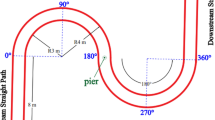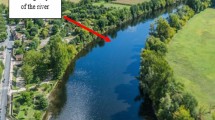Abstract
Numerous bridges are destroyed worldwide every year mostly due to the role of hydraulic factors including scour being ignored when they are designed. Therefore, examination of the scour phenomenon around bridge piers in rivers and identification of the parameters affecting them gain a great level of significance. Particularly, if the bridge piers are installed at river bends, the complicated nature of the flow in bends adds to complications already existent in analysis of flow and scour patterns around such structures, which indicates the need for further study. Hence, the present study has utilized SSIIM numerical model to analyze the three-dimensional flow and scour patterns around perpendicular pier groups (two series of triad parallel piers) at different positions of a bended channel (at the 60-, 90-, and 120-degree angles). The simulated bended channel is a 1-m-wide channel with a central angle of 180 degrees and a relative curvature radius of 2. These data are first compared and confirmed with data collected by acoustic Doppler velocimetry under similar conditions for validation of the numerical data. The results obtained from this model indicated that changing the position of the bridge piers in the channel does not have a significant effect on the maximum scour value; however, the amount of the maximum sedimentation increases by 12% after relocating the piers from the 60- to the 90-degree angle, whereas relocating them from the 90- to the 120-degree position leads to a 42% reduction in the maximum sedimentation.














Similar content being viewed by others
References
Laursen EM, Toch A (1956) Scour around bridge piers and abutments. Iowa Highway Research Board, Iowa
Laursen EM (1963) An analysis of relief bridge scour. J Hydraul Div 89:93–118
Jain SC, Fischer EE (1980) Scour around bridge piers at high flow velocities. J Hydraul Div 106:1827–1842
Raudkivi AJ, Ettema R (1983) Clear-water scour at cylindrical piers. J Hydraul Eng 109:338–350. https://doi.org/10.1061/(ASCE)0733-9429(1983)109:3(338)
Melville BW (1984) Live-bed scour at bridge piers. J Hydraul Eng 110:1234–1247. https://doi.org/10.1061/(ASCE)0733-9429(1984)110:9(1234)
Melville BW, Sutherland AJ (1988) Design method for local scour at bridge piers. J Hydraul Eng 114:1210–1226. https://doi.org/10.1061/(ASCE)0733-9429(1988)114:10(1210)
Dargahi B (1990) Controlling mechanism of local scouring. J Hydraul Eng 116:1197–1214. https://doi.org/10.1061/(ASCE)0733-9429(1990)116:10(1197)
Yanmaz AM, Altmbilek HD (1991) Study of time-dependent local scour around bridge piers. J Hydraul Eng 117:1247–1268. https://doi.org/10.1061/(ASCE)0733-9429(1991)117:10(1247)
Richardson EV, Davis SR (1995) Evaluating scour at bridges. Federal Highway Administration Hydraulic Engineering, Office of Technology Applications, Washington
Richardson JE, Panchang VG (1998) Three-dimensional simulation of scourinducing flow at bridge piers. J Hydraul Eng 124:530–540. https://doi.org/10.1061/(ASCE)0733-9429(1998)124:5(530)
Bozkus Z, Yildiz O (2001) Experimental investigation of scouring around inclined bridge piers. Wetlands Engineering and River Restoration Conference, Nevada, USA. https://doi.org/10.1061/40581(2001)122
Huang W, Yang Q, Xiao H (2009) CFD modeling of scale effects on turbulence flow and scour around bridge piers. Comput Fluids 38:1050–1058. https://doi.org/10.1016/j.compfluid.2008.01.029
Keshavarzi A, Melville B, Ball J (2014) Three-dimensional analysis of coherent turbulent flow structure around a single circular bridge pier. Environ Fluid Mech 14:821–847. https://doi.org/10.1007/s10652-013-9332-1
Vaghefi M, Ghodsian M, Salimi S (2016) The effect of circular bridge piers with different inclination angles toward downstream on scour. Sadhana 41:75–86. https://doi.org/10.1007/s12046-015-0443-x
Ben Mohammad Khajeh S, Vaghefi M, Mahmoudi A (2017) The scour pattern around an inclined cylindrical pier in a sharp 180-degree bend: an experimental study. Int J River Basin Manag 15:207–218. https://doi.org/10.1080/15715124.2016.1274322
Breusers HNC, Raudkivi AJ (1991) Scouring. Hydraulic structures design manual. Balkema, Rotterdam
Hannah CR (1978) Scour at pile groups. Research Rep. No. 78-3, University of Canterbury, New Zealand
Nazariha M (1996) Design relationships for maximum local scour depth for bridge pier groups. University of Ottawa, Canada. https://doi.org/10.20381/ruor-16601
Zarrati AR, Nazariha M, Mashahir MB (2006) Reduction of local scour in the vicinity of bridge pier groups using collars and riprap. J Hydraul Eng 132:154–162. https://doi.org/10.1061/(ASCE)0733-9429(2006)132:2(154)
Bozkus Z, Cesme M (2010) Reduction of scouring depth by using inclined piers. Can J Civil Eng 37:1621–1630. https://doi.org/10.1139/L10-099
Özalp MC (2013) Experimental investigation of local scour around bridge pier groups. In: 21st Canadian hydrotechnical conference, Alberta, Canada
Beg M, Beg S (2015) Scour hole characteristics of two unequal size bridge piers in tandem arrangement. ISH J Hydraul Eng 21:85–96. https://doi.org/10.1080/09715010.2014.963176
Islam SU, Rahman H, Ying ZC, Saha SC (2016) Comparison of wake structures and force measurements behind three side-by-side cylinders. J Braz Soc Mech Sci Eng 38:843–858. https://doi.org/10.1007/s40430-014-0297-x
Jaman H, Das S, Kuila A, Mazumdar A (2017) Hydrodynamic flow patterns around three inline eccentrically arranged circular piers. Arab J Sci Eng 42:3973–3990. https://doi.org/10.1007/s13369-017-2536-9
Vaghefi M, Tabibnezhad MJ, Hashemi SS, Moradi S (2018) Experimental study of bed topography variations due to placement of a triad series of vertical piers at different positions in a 180° bend. Arab J Geosci 11:102–115. https://doi.org/10.1007/s12517-018-3443-4
Asadollahi M, Vaghefi M, Tabib Nazhad Motlagh MJ (2019) Experimental and numerical comparison of flow and scour patterns around a single and triple bridge piers located at a sharp 180 degrees bend. Sci Iran Trans A (Published Online). https://doi.org/10.24200/sci.2019.5637.1391
Alemi M, Maia R (2018) Numerical simulation of the flow and local scour process around single and complex bridge piers. Int J Civ Eng 16:475–487. https://doi.org/10.1007/s40999-016-0137-8
Hamidi A, Siadatmousavi SM (2018) Numerical simulation of scour and flow field for different arrangements of two piers using SSIIM model. Ain Shams Eng J 9:2415–2426. https://doi.org/10.1016/j.asej.2017.03.012
Mohammad V, Yaser S, Shaker HS (2016) Effects of distance between the T-shaped spur dikes on flow and scour patterns in 90° bend using the SSIIM model. Ain Shams Eng J 7:31–45. https://doi.org/10.1016/j.asej.2015.11.008
Vaghefi M, Radan P, Akbari M (2019) Flow pattern around attractive, vertical, and repelling t-shaped spur dikes in a mild bend using CFD modeling. Int J Civ Eng 17:607–617. https://doi.org/10.1007/s40999-018-0340-x
Vaghefi M, Akbari M (2019) A procedure for setting up 180-degree sharp bend flume including construction and examinations with hydraulic structures. Sci Iran Trans A (Published Online). https://doi.org/10.24200/sci.2018.5033.1054
Vaghefi M, Akbari M, Fiouz A (2016) An experimental study of mean and turbulent flow in a 180 degree sharp open channel bend: secondary flow and bed shear stress. KSCE J Civ Eng 20:1582–1593. https://doi.org/10.1007/s12205-015-1560-0
Baghalian S, Ghodsian M (2017) Experimental analysis and prediction of velocity profiles of turbidity current in a channel with abrupt slope using artificial neural network. J Braz Soc Mech Sci Eng 39:4503–4517. https://doi.org/10.1007/s40430-017-0867-9
Melville BW, Chiew YM (1999) Time scale for local scour at bridge Piers. J Hydraul Eng 125:59–65. https://doi.org/10.1061/(ASCE)0733-9429(1999)125:1(59)
Chiew Y (1992) Scour protection at bridge piers. J Hydraul Eng 118:1260–1269. https://doi.org/10.1061/(ASCE)0733-9429(1992)118:9(1260)
Olsen NRB (2007) Computational fluid dynamics in hydraulic and sedimentation engineering. Class notes, Norwegian University of Science and Technology, Trondheim
Beccati N, Ferrari C, Bonanno A, Balestra M (2019) Calibration of a CFD discharge process model of an off-road self-loading concrete mixer. J Braz Soc Mech Sci Eng 41:76. https://doi.org/10.1007/s40430-019-1578-1
Nayyer S, Farzin S, Karami H, Rostami M (2019) A numerical and experimental investigation of the effects of combination of spur dikes in series on a flow field. J Braz Soc Mech Sci Eng 41:256. https://doi.org/10.1007/s40430-019-1757-0
Vaghefi M, Faraji B, Akbari M, Eghbalzadeh A (2018) Numerical investigation of flow pattern around a T-shaped spur dike in the vicinity of attractive and repelling protective structures. J Braz Soc Mech Sci Eng 40:93–107. https://doi.org/10.1007/s40430-017-0954-y
Vaghefi M, Safarpoor Y, Akbari M (2017) Numerical comparison of the parameters influencing the turbulent flow using a T-shaped spur dike in a 90° bend. J Appl Fluid Mech 10:231–241. https://doi.org/10.18869/acadpub.jafm.73.238.26175
Vaghefi M, Safarpoor Y, Akbari M (2016) Numerical investigation of flow pattern and components of three-dimensional velocity around a submerged T-shaped spur dike in a 90 degree bend. J Cent South Univ Tech 23:2984–2998. https://doi.org/10.1007/s11771-016-3362-z
Olsen NRB (2007) A three dimensional numerical model for simulation of sediment movements in water intakes with multiblock option. Norwegian University of Science and Technology, Trondheim, Norway, Online User’s manual
Olsen NRB, Jimenes OF, Abrahamsen L, Lovoll A (1999) 3D CFD modeling of water and sediment flow in a hydropower reservoir. J Soils Sediment 14:16–24. https://doi.org/10.1007/s11368-018-1989-0
Schlichting H (1960) Boundary layer theory. McGraw-Hill, New York
Shukry A (1950) Flow around bends in an open flume. T Am Soc Civ Eng 115:751–779
Author information
Authors and Affiliations
Corresponding author
Additional information
Technical Editor: Daniel Onofre de Almeida Cruz, D.Sc.
Publisher's Note
Springer Nature remains neutral with regard to jurisdictional claims in published maps and institutional affiliations.
Rights and permissions
About this article
Cite this article
Asadollahi, M., Vaghefi, M. & Akbari, M. Effect of the position of perpendicular pier groups in a sharp bend on flow and scour patterns: numerical simulation. J Braz. Soc. Mech. Sci. Eng. 42, 422 (2020). https://doi.org/10.1007/s40430-020-02503-2
Received:
Accepted:
Published:
DOI: https://doi.org/10.1007/s40430-020-02503-2




